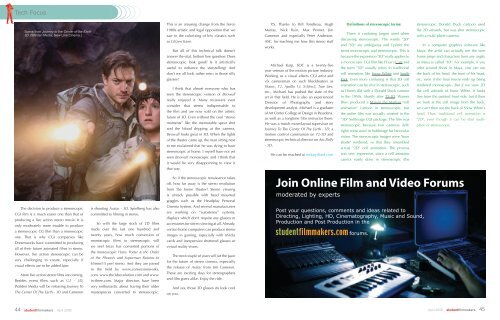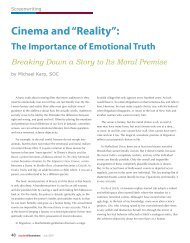The Digital Stereoscopic - Michael Karp
The Digital Stereoscopic - Michael Karp
The Digital Stereoscopic - Michael Karp
Create successful ePaper yourself
Turn your PDF publications into a flip-book with our unique Google optimized e-Paper software.
Tech Focus<br />
Scene from Journey to the Center of the Earth<br />
3D. (Walden Media; New Line Cinema.)<br />
<strong>The</strong> decision to produce a stereoscopic<br />
CGI film is a much easier one than that of<br />
producing a live action stereo movie. It is<br />
only moderately more trouble to produce<br />
a stereoscopic CG film than a monoscopic<br />
one. That is why CGI companies like<br />
Dreamworks have committed to producing<br />
all of their future animated films in stereo.<br />
However, live action stereoscopic can be<br />
very challenging to create, especially if<br />
visual effects are to be added later.<br />
More live action stereo films are coming.<br />
Besides event films such as U2 - 3D,<br />
Walden Media will be releasing Journey To<br />
<strong>The</strong> Center Of <strong>The</strong> Earth - 3D and Cameron<br />
44 studentfilmmakers April 2008<br />
is shooting Avatar - 3D. Spielberg has also<br />
committed to filming in stereo.<br />
So with the large stock of 2D films<br />
made over the last one hundred and<br />
twenty years, how much conversion of<br />
monoscopic films to stereoscopic will<br />
we see? Imax has converted portions of<br />
the monoscopic Harry Potter & the Order<br />
of the Phoenix and Superman Returns to<br />
65mm/15 perf stereo. And they are joined<br />
in the field by www.conversionworks.<br />
com, www.the3drevolution.com and www.<br />
in-three.com. Major directors have been<br />
very enthusiastic about having their older<br />
masterpieces converted to stereoscopic.<br />
This is an amusing change from the fierce<br />
1980s artistic and legal opposition that we<br />
saw to the colorizing of b/w classics such<br />
as Citizen Kane.<br />
But all of this technical talk doesn’t<br />
answer the vital, bottom line question: Does<br />
stereoscopic look good? Is it artistically<br />
useful to enhance the storytelling? And<br />
don’t we all look rather retro in those silly<br />
glasses?<br />
I think that almost everyone who has<br />
seen the stereoscopic version of Beowulf<br />
really enjoyed it. Many reviewers even<br />
consider that stereo indispensable to<br />
the film and are now sold on the artistic<br />
future of 3D. Even without the cool “stereo<br />
moments” like the memorable spear shot<br />
and the blood dripping at the camera,<br />
Beowulf looks great in 3D. When the lights<br />
of the theater came up, the man sitting next<br />
to me exclaimed that he was dying to have<br />
stereoscopic at home. I myself have not yet<br />
seen Beowulf monoscopic and I think that<br />
it would be very disappointing to view it<br />
that way.<br />
So if the stereoscopic renaissance takes<br />
off, how far away is the stereo revolution<br />
from the home theater? Stereo viewing<br />
is already possible with head mounted<br />
goggles such as the Headplay Personal<br />
Cinema System. And several manufacturers<br />
are working on “autostereo” systems,<br />
displays which don’t require any glasses or<br />
accessories for stereo viewing at all. Already,<br />
certain home computers can produce stereo<br />
images in gaming, especially with nVidia<br />
cards and inexpensive shuttered glasses or<br />
virtual reality visors.<br />
<strong>The</strong> next couple of years will set the pace<br />
for the future of stereo cinema, especially<br />
the release of Avatar from Jim Cameron.<br />
<strong>The</strong>se are exciting days for stereographers<br />
and film goers alike. Enjoy the ride.<br />
And yes, those 3D glasses do look cool<br />
on you.<br />
P.S. Thanks to Bill Tondreau, Hugh<br />
Murray, Nick Ilyin, Max Penner, Jim<br />
Cameron and especially Peter Anderson,<br />
ASC, for teaching me how this stereo stuff<br />
works.<br />
<strong>Michael</strong> <strong>Karp</strong>, SOC is a twenty-five<br />
year veteran of the motion picture industry.<br />
Working as a visual effects CGI artist and<br />
vfx cameraman on such blockbusters as<br />
Titanic, T2, Apollo 13, X-Men2, True Lies,<br />
etc., <strong>Michael</strong> has pushed the state of the<br />
art in that field. He is also an experienced<br />
Director of Photography and story<br />
development analyst. <strong>Michael</strong> is a graduate<br />
of Art Center College of Design in Pasadena,<br />
as well as a longtime film instructor there.<br />
He was a match move/layout supervisor on<br />
Journey To <strong>The</strong> Center Of <strong>The</strong> Earth - 3D, a<br />
motion control cameraman on T2-3D and<br />
stereoscopic technical director on Ant Bully<br />
- 3D.<br />
He can be reached at mckarp@aol.com<br />
Definitions of stereoscopic terms:<br />
<strong>The</strong>re is confusing jargon used when<br />
discussing stereoscopic. <strong>The</strong> words "2D"<br />
and "3D" are ambiguous and I prefer the<br />
terms monoscopic and stereoscopic. This is<br />
because the expression "3D" really applies to<br />
a monoscopic CGI film like Pixar's Cars and<br />
the term "2D" usually refers to traditional<br />
cell animation like Snow White and South<br />
Park. Even more confusing is that 2D cell<br />
animation can be shot in stereoscopic, such<br />
as Disney did with a Donald Duck cartoon<br />
in the 1950s. Shortly after T2-3D, Warner<br />
Bros. produced a Marvin the Martian "cell<br />
animation" cartoon in stereoscopic, but<br />
the entire film was actually created in the<br />
"3D" SoftImage CGI package. <strong>The</strong> film was<br />
stereoscopic because two cameras (left/<br />
right) were used in SoftImage for binocular<br />
vision. <strong>The</strong> stereoscopic images were "toon<br />
shade" rendered, so that they resembled<br />
actual "2D" cell animation. <strong>The</strong> process<br />
was very impressive, since a cell animator<br />
cannot easily draw in stereoscopic (the<br />
stereoscopic Donald Duck cartoon used<br />
flat 2D artwork, but was shot stereoscopic<br />
with a multi-plane camera).<br />
In a computer graphics software like<br />
Maya, the artist can actually see the wire<br />
frame props and characters from any angle,<br />
so Maya is called "3D". For example, if you<br />
orbit around Shrek in Maya, you can see<br />
the back of his head, the front of his head,<br />
etc, even if the final movie ends up being<br />
rendered monoscopic. But if we view 2D<br />
flat cell artwork of Snow White, it looks<br />
fine from the painted front side, but if then<br />
we look at the cell image from the back,<br />
we can't then see the back of Snow White's<br />
head. Thus, traditional cell animation is<br />
"2D", even though it can be shot multi-<br />
plane or stereoscopic.<br />
Join Online Film and Video Forums<br />
moderated by experts<br />
Post your questions, comments and ideas related to<br />
Directing, Lighting, HD, Cinematography, Music and Sound,<br />
Production and Post Production in the<br />
forums.<br />
April 2008 studentfilmmakers 45



